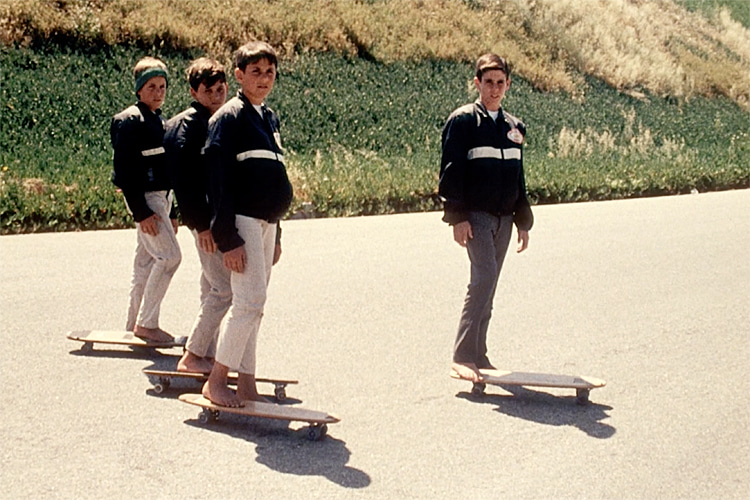In 1965, the movie "Skaterdater" rolled through every major theater in America and in many countries around the world.
It was the first major Hollywood film that brought the sport of skateboarding into our living rooms.
For those of us skateboarders and surfers who were alive then, the movie found a special place in our hearts and memories forever - much like what "The Endless Summer" did to surfing during the same time period.
Those of us not yet born discovered it later in the video and film libraries of our high schools and universities.
Time Magazine, in an April 1966 movie review, called the story of "Skaterdater" a minor theme polished to a "professional perfection - a swift, sensitive and funny celebration of a small universal truth. Succinct as poetry, 'Skaterdater' simply happens like a Spring morning; it is the lyric cinematic equivalent of light verse."
A short subject film (runs about 18 minutes), "Skaterdater" was nominated for an Oscar in the 1965 Academy Award presentations.
In May 1966, it was the short subject Golden Palm Grand Prix winner in the Cannes Film Festival - the only American film to be awarded a prize in that festival.
It went on to win seven other prestigious international awards.
The film's story is quite simple: a group of hotshot skateboarders are loyal to each other and skate together through a variety of freewheeling adventures throughout a California beach city.
The leader of the group, by accident, runs into a girl, and his allegiance to the group diminishes as he begins to spend his time with her.
A romance blossoms. The others ridicule their leader and no longer consider him one of them.
He attempts to re-enter the group and regain leadership, which reaches a climax when he is forced to prove himself in a "battle of the boards."
He is challenged by the new leader to descend down a long hill, with each attempting to wipe out the other on the way down.
The one to remain on this board becomes the acknowledged leader.
Gregg Carroll, the film's co-star, was ironically and until recently a very active skateboarder and surfer.
Gregg was 12 when the film was made. He lived in Santa Barbara, CA, and surfed daily for a long time at many of the famous spots up and down the California coast, including Rincon, Trestles, Malibu, Salt Creek, and San Onofre.
Some of his favorite secret skateboard spots could be found in the steep hills of San Clemente, Santa Barbara, and Laguna Niguel.
He was a pioneer in two extreme sports, and his credentials go something like this: at 12 years old, he was a member of the famous skateboard club he co-founded called "The Imperials" (members of the club comprised the cast of "Skaterdater"), a member of the world-renown Makaha Skateboard Exhibition Team, member of the Bay Cities Surf Club, and member of the Jacobs Surf Team.
In 1964, he placed third in the National Skateboard Championships held at the Santa Monica Civic Auditorium, first at the Manhattan Beach Valley Drive Open, and first at the Hermosa Beach Pier Avenue Open, and he was a top-place finisher at the World Skateboard Championships held in 1965 in Anaheim, CA.
We asked Gregg to tell us in his own words what it was like to make the short subject classic in the mid-1960s. This is his story:
Gregg Carroll: The Co-Star of "Skaterdater"
The making of "Skaterdater" was more than producers, directors, and writers coming together to make a film.
It was ultimately the outcome of widely diverse personalities, places, and events celebrating life in a more innocent time, with the sport of skateboarding serving as the centerpiece.
There is no way that one could write about the making of "Skaterdater" without sharing some of the rich history of the early days of skateboarding.
I started skateboarding in 1960 when I was eight years old.
My first skateboard was made of a sawed-off two-by-four with a steel skate nailed to the bottom.
I spray-painted it with some silver paint, and it became my mode of transportation to school, and everywhere else I went.
My home was located in Torrance, California, and it seemed like every young kid in the neighborhood was riding a skateboard of some shape and color.
By 1962, homemade skateboards were giving way to store-bought steel-wheeled skateboards made by the Roller Derby Company.
The red Roller Derby skateboards were far superior to the homemade boards we were riding at the time.
Roller Derby Skateboards became the "benchmark" for all steel-wheeled skateboards at that time. There were many knock-offs, but none were as good as Roller Derby.
It stayed that way until around 1963 when Larry Stevenson introduced the Makaha Skateboard that utilized Chicago clay wheels.
Larry is indisputably the father of modern skateboarding.
There is nobody that has contributed to the advancement of skateboarding as much as him.
Nobody.
In those days, owning a Makaha Skateboard was like advancing car ownership from a Ford Model T to a classic Rolls Royce.
The outline symmetrical shape of a Makaha skateboard looked like a surfboard.
The beautiful wood grain was sanded smooth with a shiny lacquer finish. State-of-the-art Chicago skate trucks with clay wheels were positioned perfectly on the bottom of the board.
A special skate key was used to adjust the trucks to maximize speed and turning.
There was nothing in the world I wanted more for my eleventh birthday than a Makaha Skateboard.
Even though I didn't receive one, my dad made me an almost exact copy. It was an absolute work of art and a major step up in equipment at that time.
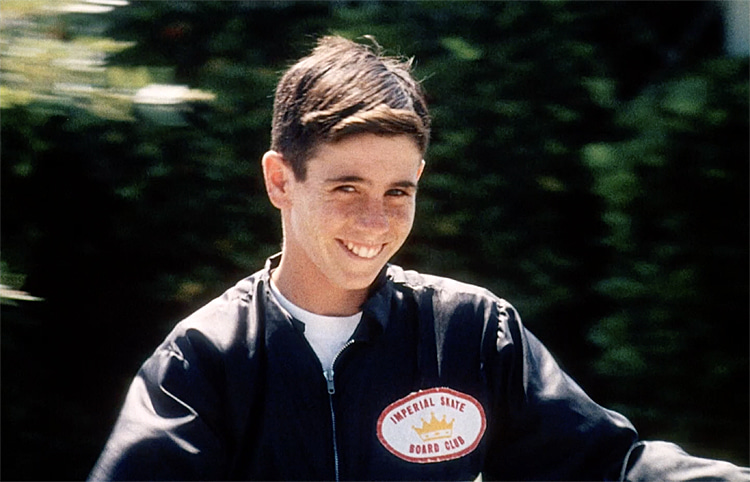
The Imperials
A lot of my best friends in the neighborhood were also riding highly improved skateboards, and we began to skate around town together.
My best friend at the time was a guy named Gary Hill, and one day in our sixth-grade class, we came up with the idea of starting a skateboard club.
We thought it would be really cool to design jackets and t-shirts with our club name and logo on them.
Initially, we asked all our best friends to join, with no other goal in mind except to share in the thrill of skateboarding.
The club we founded was named the Imperial Skateboard Club, or in short, The Imperials.
Eventually, we held tryouts for our club on the grounds of a local high school, and they attracted hundreds of kids from all over the local beach towns where we lived.
In the summer of 1964, The Imperials entered their first major skateboard competition held at Lincoln Park in Santa Monica, CA.
At the time, it was one of the big annual skateboard competitions.
Contestants included Brad "Squeak" Blank, Torger Johnson, Danny Bearer, Davey and Steve Hilton, John Fries, and other guys that were members of the Makaha and Hobie Skateboard Exhibition Teams.
The contest focused on tricks and flatland slalom.
Tricks at the time were pretty basic and included 360s (most consecutive), wheelies, kick-turns, forward and backward board walking, and stylish turns.
Although none of The Imperials were finalists in the contest, we got out first taste of a major skateboard competition and what would be required to win in the future.
Over the next several months, The Imperials practiced new tricks every day after school.
We met on the tennis courts of a local high school and "spotted" each other like gymnasts as we attempted new tricks that included nose-wheelies, headstands, handstands, curb jumping, and high jumping.
To remain a member of the club, you had to demonstrate significantly advanced prowess in your skateboarding skills, or you were kicked out of the club.
As a result, the club's overall skateboarding ability was very high.
A few of the members were extremely innovative and creative in developing new techniques and tricks.
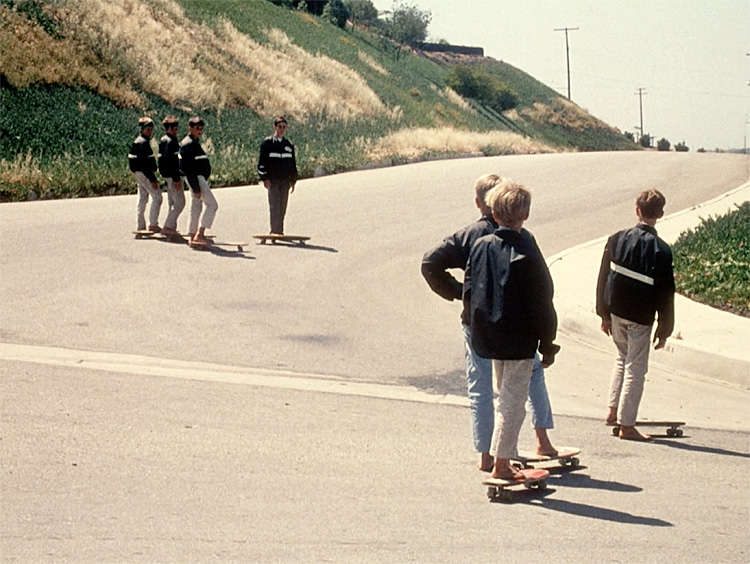
The Skate Contest at The Civic
In the early 1960s, one of the major surfing events held every year was the Mid-Winter Surfing Championships at Santa Monica State Beach in Southern California.
It drew top surfers from across the United States and around the world.
In December of 1964, the first National Skateboard Championships were added to the surf contest's venue.
It attracted top skateboarders from up and down the California coast, as well as some contestants from New York, Florida, and Texas.
Many of the top skateboarders, who had competed in the contest held six months earlier at Lincoln Park, were entered in the competition.
The contest was actually held at the Santa Monica Civic Auditorium instead of at the beach.
It had been home to Academy Award presentations many times and offered theater-like spectator seating that overlooked a huge open floor area.
The floor surface was like polished cement and didn't provide very good traction for either the trick or flatland slalom events.
One of the club member's Moms drove us to the event that was about 20 miles from our homes located in Redondo Beach.
Eight of us were crammed into a station wagon along with all our skateboards.
I'll never forget the sight as we drove into the parking lot at The Civic.
The giant marquis sign outside the auditorium read "National Skateboard Championships," along with the date of the event.
I remember the butterflies in my stomach when I read the sign. The giant sprawling parking lot was already almost full of cars at 7:00 in the morning.
There were hundreds and hundreds of kids skateboarding everywhere outside, inside, and even in the Civic Auditorium.
It was as though every skateboarder in the world had shown up for the event.
As nervous as we all were, we piled out of the car, jumped on our skateboards, and skated across the parking lot up to the auditorium's glass doors.
There was massive pandemonium as we walked into the auditorium. Hundreds of kids practiced their repertoire of tricks on the slippery auditorium floor before the competition began.
Almost all of the seats were taken.
We knew it was going to be a long day, and my friend's mom was finally able to find some seats for everyone.
The thundering sound of the announcer's voice echoed through the auditorium as all contestants were requested to vacate the floor so the competition could begin.
As the day wore on, The Imperials continued to advance in the competition.
Although the competition was fierce, we had practiced and trained hard every day since the Lincoln Park contest.
During the early-morning practice sessions, we were blowing everyone away with some of the new tricks we had learned that included headstands, handstands, nose wheelies, nose 360s, jumps, etc.
I'm not sure if I can take credit for inventing the nose-wheelie (riding on only the front two wheels of the skateboard), but I was the first person to perform one in a major competition.
I remember skating the entire length of the auditorium past spectators in the stands, much like an ice skater does to gain momentum before executing a big trick.
As I reached the end of the auditorium, I gave a few hard pushes with my foot to get the speed and went into a nose-wheelie that stretched the entire length of the auditorium.
I remember everyone standing and cheering at the top of their lungs as I sat my skateboard back down on all four wheels and immediately transitioned into a headstand that also went the entire length of the auditorium.
As I looked up while exiting the floor, the entire audience was on their feet, applauding and cheering.
The thunderous echo in the auditorium was so overwhelming that I burst into tears as I made my way back to where the rest of my club was sitting.
My friend's mom was also in tears as she hugged and congratulated me.
Ultimately, The Imperials swept the finals of the competition.
My friend Mike Mel, who was my co-star in "Skaterdater," took first, and I took third in the overall competition.
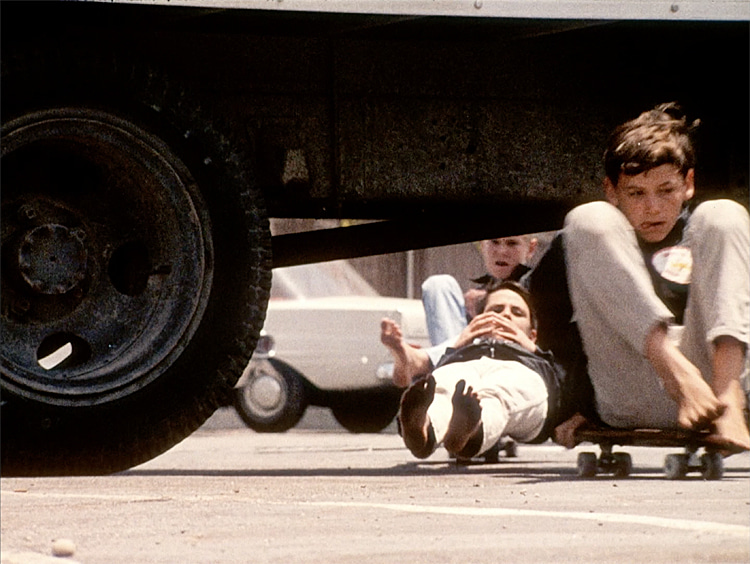
Noel Black and The Birth of "Skaterdater"
The Imperials, a skateboard club from a small California beach town, had become a major reckoning force in the newly emerging sport of skateboarding.
We had beaten everyone on the then-famous Makaha and Hobie Skateboard Exhibition Teams.
It was at this contest that the movie "Skaterdater" found its birth.
During the national competition, it became evident that The Imperials were going to be many of the finalists in the competition.
As I sat in the stands waiting for my turn on the floor, a man in his early twenties approached me.
He introduced himself as Noel Black and said he was going to be making a Hollywood film that centered on skateboarding.
He went on to say how he wanted The Imperials to be primary members of the film's cast.
Initially, I thought he was some kind of a quack and blew him off.
Ultimately though, I thought he was sincere and gave him my home phone number.
Several weeks had passed after the national championships when one evening, the phone rang at my home.
I picked up the phone, and Noel Black was at the other end.
He began to recant what we talked about at the contest regarding The Imperials starring in his upcoming Hollywood film production.
He asked if it would be OK to talk to one of my parents.
As I stood in front of my mom while she talked to Noel, I could tell by the dialogue that he was sharing his credentials with her, and she was obviously impressed with what she had heard.
The conversation ended with my mom promising that either she or I would call him back within the week.
After hanging up, my mom asked me what I thought about the opportunity. I told her that it sounded great.
It sounded like The Imperials would get a lot of publicity, and we could have a lot of fun doing it.
Eventually, all the kids and our parents met to discuss what commitment would be required to make the film.
All the parents agreed to stay pretty much out of it.
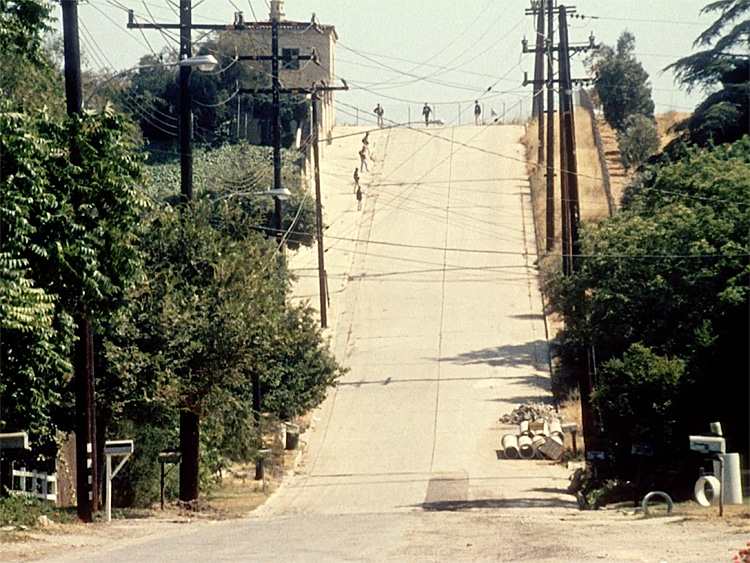
Riding Hobie Skateboards
The making of the film would require members of the club to film after school every day and on weekends for six months.
We all agreed to do it, and I called Noel to share the news. Within a week, all of The Imperials and their parents met with Noel to discuss most of the details.
Noel was a graduate of UCLA's School of Cinematography.
His partner was a guy named Marshal Backlar, who was a graduate of Princeton's School of Business.
Marshal was the producer, and Noel would be the director. At that time, neither had any other Hollywood projects to their credit.
The film was made on a shoestring budget with camera equipment that was borrowed from one of the Hollywood studios.
Mike Murphy, an acclaimed Hollywood cameraman at that time, did the camera work.
Friends of both Noel and Marshal served as soundmen, grips, etc., over what ultimately became almost a year of filming.
Just before the filming of "Skaterdater" began, I received a phone call from Dave Rochlen Jr.
Dave was the "commander" of the Hobie Skateboard Exhibition team and a then-famous Malibu surfer.
He asked if he and some guys on the Hobie Team could come down and skate with The Imperials for a day.
He also asked if he could bring some brand-new Hobie Skateboards for The Imperials to ride.
Since Hobie and Makaha Skateboards were the Rolls Royces of skateboards at the time, I didn't hesitate for a second.
I asked Dave to meet us the following Saturday morning in front of the gymnasium at a local high school where we often practiced.
Ironically, the High School was named South High, and almost four decades later, it became the setting for many scenes of the film "American Beauty," which starred Kevin Spacey.
I was gigantically stoked, as were the rest of The Imperials, because we would have brand new Hobie Skateboards to ride when filming began and in the upcoming International Skateboard Championships being held in Anaheim, CA.
Dave showed up like clockwork the following Saturday.
He brought Danny Bearer, Davey Hilton, and Torger Johnson with him and a car trunk filled with boxes of brand-new Hobie skateboards.
The entire Hobie Skateboard team had already graced pages of the new Skateboarder Magazine, and Davey Hilton (Hilton Hotels) had been on the magazine's first cover shot.
All of The Imperials were blown away as they opened big white boxes and pulled out the beautifully crafted Hobie Skateboards.
They looked like an artisan's piece of work.
The boards were comprised of several pieces of dark and light woods that were laminated together with a shiny lacquer finish applied.
The Hobie sticker was positioned perfectly in the center of the board's tail section. They were the only skateboards at the time that offered skate trucks with white wheels.
We all jumped on the new skateboards and skated over to an area where we always practiced.
The superior construction of the boards made tricks like handstands, headstands, and nose wheelies a lot easier to perform.
We all skated together for hours as new friendships were spawned, but there was an obvious competitive rivalry between The Imperials and the guys from Hobie.
I think they were still stinging from the upset at the National Championships.
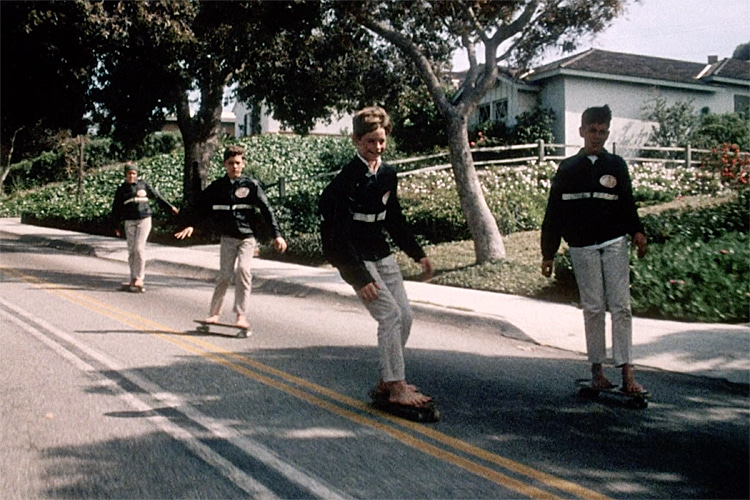
Fun But Demanding
The making of "Skaterdater" was a lot of fun but, at times, very demanding for a group of young 12-year-old.
The actual filming was originally estimated to last six months but went on for almost a year.
There were a lot of times that we just wanted to go skateboarding at one of our favorite spots but would have to meet somewhere after school or on the weekend to film.
Noel had originally asked me if I wanted to star in the film.
I was receptive to the idea but changed my mind when he told me I would have to do a lot of scenes (including kissing and holding hands) with a girl of his choice versus my girlfriend at the time.
My girlfriend was really cute and had a great personality but had no film experience.
The girl Noel cast for the part had done numerous Chevrolet commercials for TV and was experienced in front of the camera.
The starring role went to my friend Mike Mel after I had turned it down.
Most of "Skaterdater" was filmed in Southwest Los Angeles, including the cities of Santa Monica, Redondo Beach, Palos Verdes, and Lomita.
Members of the cast had to deal with a lot of the same things that anyone else does when making a film, including dealing with the boredom of being at a location all day to film only a short scene.
Since the cast was mostly comprised of The Imperials, a lot of mischievous acts were always in the making.
For instance, one day, we were all sitting on the front lawn of a beautiful home in a prestigious neighborhood when we stripped one of the younger members of the club of all his clothes and threw them up in a tree as we skateboarded down the street.
He was left hiding in the bushes until we returned about an hour later and helped him get his clothes out of the tree.
None of us liked the girl that Noel had cast in the film.
As a result, we were always playing practical jokes on her until we would make her cry while we howled with laughter.
I remember another occasion when we had a major ice cream fight in a restaurant after completing a day of filming.
It got so out of control that the management asked us to leave and never return.
I remember all of us were covered with ice cream and toppings as we were ushered out of the restaurant.
Noel was really pissed because other customers in the restaurant were also hit with the flying ice cream being thrown by eight pre-teen skateboard maniacs.
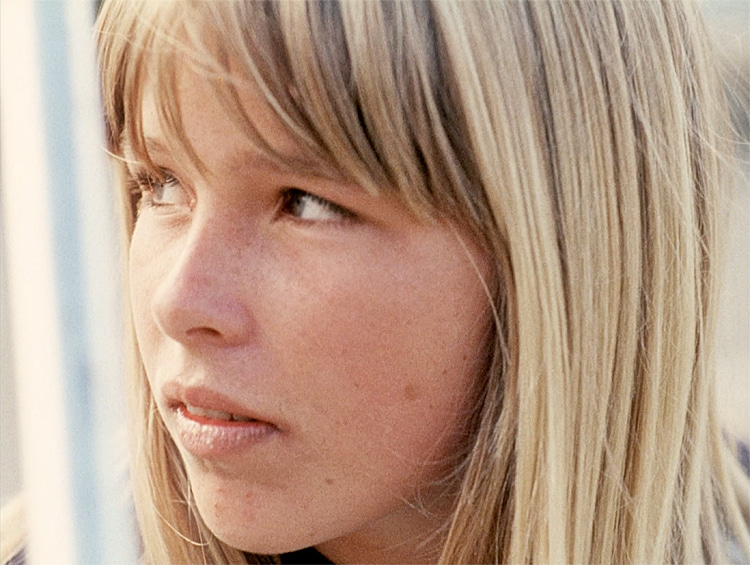
The Duel Scenes
The final "duel" in the film between Mike Mel and I was filmed on a street in Lomita, California, called Cypress Street.
It really was a pretty steep and treacherous hill.
The cement had been poured in 1920, so it wasn't really smooth, and there was a crack about one inch wide that ran down the center of the street.
The conditions were less than ideal for the then Chicago clay wheels that would stop on a dime when they came in contact with a small rock or pebble that was on the road or sidewalk.
Although there were a few nasty wipeouts during the filming of the duel, nobody was seriously injured.
A lot of people have asked through the years exactly how the duel scenes were filmed.
They were filmed while the cameraman laid down in a bicycle-like trolley that was devised by Noel's team.
One person sat in the front of the trolley to steer and brake while the cameraman laid on his stomach and shot the film, quite often with the camera no more than a few inches off the cement as the trolley sped down the streets and hills in a high-speed chase.
I remember that we were all pretty stoked when the filming was completed.
The making of the film and the hoopla that surrounded it changed a lot of our lives over the year that the filming had taken.
There were a lot of days that many of us wanted to just go surfing after school or on the weekend, but we were committed to completing the film.
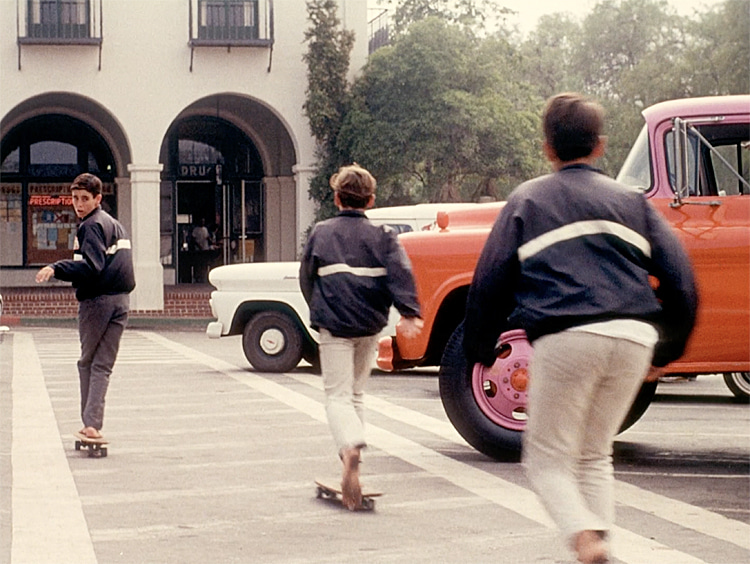
Becoming a Member of the Makaha Skateboard Exhibition Team
A couple of months after the filming of "Skaterdater" had begun, the first International Skateboard Championships were held in Anaheim, CA.
It was a huge event.
I think every kid who had a skateboard at the time, along with the hottest skateboarders in the world, showed up.
There were thousands of people attending. The competition was held in a large stadium, and the bleachers were packed with people.
ABC Wide World of Sports television cameras were set up everywhere around the competition.
It was a two-day contest that was comprised of flatland slalom, tricks, and downhill slalom. There were finalists in each event and an overall winner (based on total points earned in each event).
The Hobie Team placed well in the final competition, with John Fries being the overall winner, Torger Johnson winning the tricks event, and Danny Bearer winning the downhill slalom.
Woody Woodward from the Makaha team won the flatland slalom.
I placed a respectable eighth place in the overall competition and was a top-place finisher in the tricks and flatland events.
It was at the Anaheim Championships that Jim Ganzer (founder of Jimmy Z clothing) approached me and asked if I wanted to be on the Makaha Skateboard Exhibition Team.
I had gotten to know Jim at some of the other skateboard contest competitions held that year.
In comparison, being asked to become a member of the Makaha Skateboard Exhibition Team was comparable to being selected for an Olympic team.
Members of the Makaha Team had already been in surf movies, in skateboard magazines, and on television. Most of them were famous in their own right.
I had gotten to know one of the members of the team, Bruce Logan, during a skateboard competition held earlier that year at Pier Avenue School in Hermosa Beach.
I had also gotten to know Bruce's brothers, Brian and Brad. All of them were really great guys and world-class skateboarders.
I excitedly accepted Jim's invitation to become a member of the team.
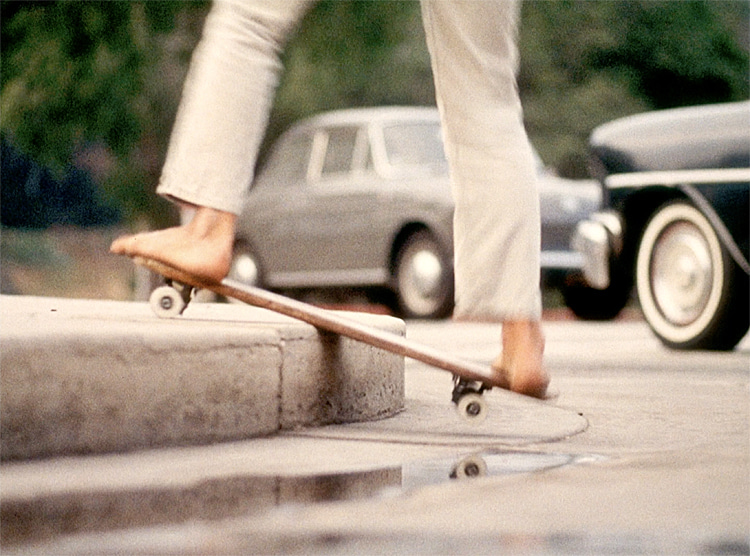
Hobie vs. Makaha
I think it's important to note the distinction between The Imperials and Makaha/Hobie Skateboard Exhibition Teams.
The Imperials were a club, and the Makaha/Hobie Skateboard Exhibition Teams gave exhibitions to promote their respective skateboard lines.
Exhibitions were usually performed on weekends at major department stores such as Macy's, with hundreds of people watching as "daredevil" tricks like headstands and handstands were performed.
It was during this time that some conflicts began to arise.
First, I had been riding Hobie Skateboards during the initial filming of "Skaterdater."
As a new member of the Makaha Team, I would be switching from riding a Hobie Skateboard to a Makaha Skateboard.
Visually, this caused problems for Noel as the director.
It meant that I would be the only Imperial in the film not riding a Hobie, and a lot of close-up camera angles had already been shot of me riding a Hobie.
Bottom line, I told Noel that becoming a member of the Makaha Team was the realization of a life dream (all of twelve years) and to just basically get over it because I was going to be riding a Makaha skateboard from there on out.
That was pretty much it. That's why when you watch the film, you will see a change in boards.
Secondly, I was now required to perform exhibitions on the weekends.
This sometimes conflicted with filming that had now stretched significantly beyond the six months promised earlier by the filmmakers.
We got around the time conflict by me doing most of my required film shots after school and performing at exhibitions on the weekends.
It was a lot of skateboarding but also a lot of fun.
The people I met and places traveled to formed memories of a lifetime.
One of the first exhibitions I performed in a while riding for Makaha was held at a Macy's store in San Francisco.
Jim Ganzer, Bruce Logan, Squeak Blank, and I flew up from Los Angeles for a one-day turnaround.
On the way to LAX, we stopped by the Makaha Skateboard factory in neighboring Marina Del Rey, where we picked up some new skateboards for the trip.
This was when I first met Larry Stevenson, who was the owner and President of the Makaha Skateboard Company.
Meeting Larry was like meeting a god. My memories of that exhibition will last forever.
Somehow, the wheels on our new skateboards weren't securely fastened.
Bruce Logan was the first one to perform in front of a few hundred people standing outside Macy's. While he was doing a headstand, the wheels came off.
Unfortunately, he was on a hill and speeding pretty fast when the accident occurred.
Bruce had the reflexes of a cat and somehow landed on his feet instead of his head. We laughed about that for years.
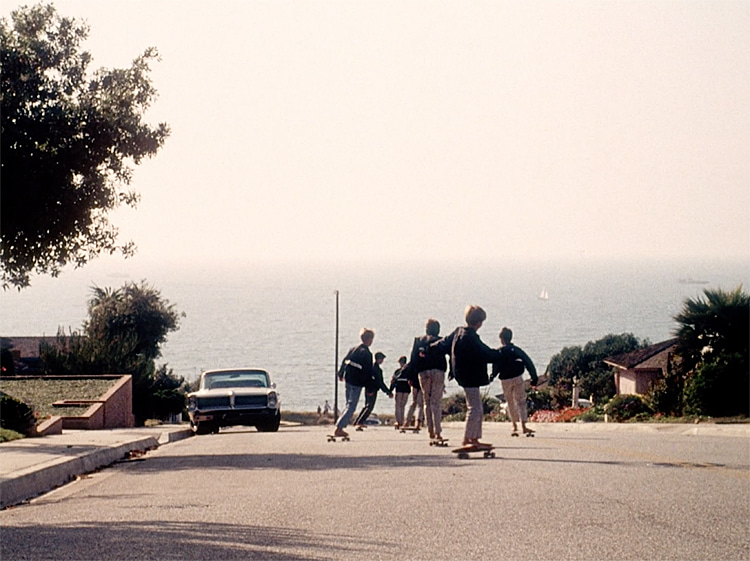
The "Skaterdater" Premiere
I was a little shy of my 13th birthday when "Skaterdater" was "put in the can," as they say in Hollywood.
I now look at my daughter Natalie and think that I was almost her age when "Skaterdater" was filmed.
All of The Imperials and their parents were invited to Mike Murphy's home in the beautiful Malibu hills for a premiere showing of the film's final cut.
I remember being in total awe as we made our way up the long winding drive that led to Mike's palatial estate.
Mike was like one of the kids during filming, always joking around and real down to earth.
He usually wore nothing more than a pair of old Levis, a t-shirt, and a pair of worn-out tennis shoes or cowboy boots.
I remember him greeting us at the huge door of his mansion and guiding us to the impeccably manicured gardens surrounding the pool area in his backyard.
A big screen had been erected next to the pool, and after all the adults had a few cocktails and appetizers, the lights were dimmed around the pool, and the projector flipped on to view "Skaterdater" for the first time.
The soundtrack by Nick Venet and Mike Curb - Mike Curb later became the Lieutenant Governor of California - blasted out of speakers that had been set up.
I remember everyone being just blown away after the film had ended.
Cheers and applause from the approximately 50 guests echoed loudly through the peaceful hills of the late Malibu evening.
It brought many of the mothers to tears.
At first, I remember my buddies and I were all sitting together, giggling and screwing around, when the projector was clicked on.
We were in a state of total awe by the time the film ended. We knew immediately that something really special had been created by Noel and his friends.
"Skaterdater" was released by United Artists in 1965 and was probably shown in every major theater in America that year as well as throughout Europe.
It won the prestigious Grand Prix Award at that year's Cannes Film Festival and was also nominated for an Academy Award.
It was also the subject of an ABC Television special narrated by Henry Fonda.
I don't think anybody at the time had any idea that the film "Skaterdater" would be the classic it has become.
Its eternal theme stands the test of time, and the cinematography is absolutely polished to brilliant perfection.
I don't think any member of The Imperials will forget how the lives of a bunch of wild ragtag kids, who innocently joined together to enjoy the thrill of skateboarding, could have been so radically changed over just a short 12-18 month period.
There was nobody in our lives at the time that hadn't seen the film, including teachers, friends, relatives, classmates, or just people behind the local store register.
On occasion, I still pull out "Skaterdater" and show it to my friends and their children or some of my daughter Natalie's friends.
I think its timeless theme, Noel's splendid direction, Mike Murphy's capturing cinematography, and the soundtrack will allow it to stay the huge little classic it has become.
Recently, I loaned a copy of the film to a friend in the neighborhood where I now live in Santa Barbara.
It somehow made its way through several other households before being returned.
I often skateboard with kids in the neighborhood, and many of them have now seen "Skaterdater." It's really hysterical because they don't call me by my first or last name.
They just call me "Skaterdater."
Preface by Michael Brooke | Skateboarder and Author of "The Concrete Wave: The History of Skateboarding"
Words by Gregg Carroll | Skateboarder and Co-Star of "Skaterdater"
